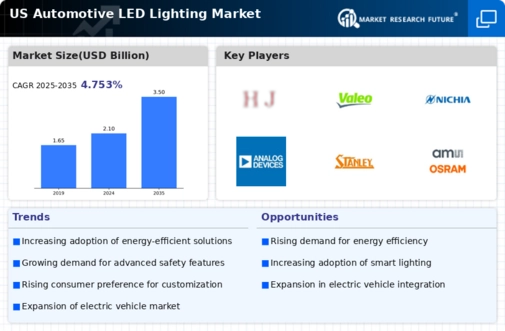Shift Towards Electric Vehicles
The transition towards electric vehicles (EVs) is a pivotal driver for the automotive led-lighting market. As EV adoption increases, manufacturers are seeking to enhance vehicle efficiency and aesthetics, with LED lighting playing a crucial role. LEDs not only provide superior illumination but also align with the eco-friendly ethos of electric vehicles. Data indicates that the EV market is projected to grow at a CAGR of over 20% in the coming years, which will likely boost the demand for LED lighting solutions. This synergy between EVs and LED technology is expected to create new opportunities within the automotive led-lighting market.
Innovations in Automotive Design
Innovations in automotive design are significantly influencing the automotive led-lighting market. As manufacturers strive to differentiate their vehicles, unique lighting designs have become a focal point. LED technology allows for greater flexibility in design, enabling the creation of distinctive light signatures and customizable features. This trend is particularly evident in luxury and high-performance vehicles, where innovative lighting solutions enhance both aesthetics and functionality. As design trends evolve, the automotive led-lighting market is poised to benefit from the increasing integration of advanced lighting technologies, catering to consumer preferences for personalized and visually striking vehicles.
Cost-Effectiveness of LED Technology
The automotive led-lighting market is experiencing growth due to the cost-effectiveness of LED technology. Although the initial investment in LED lighting may be higher than traditional options, the long-term savings are substantial. LEDs have a lifespan of approximately 25,000 hours, significantly reducing replacement costs and maintenance efforts. Furthermore, the energy efficiency of LEDs translates to lower operational costs, making them an attractive option for both manufacturers and consumers. As the automotive industry increasingly recognizes these financial benefits, the adoption of LED lighting is likely to accelerate, further propelling the automotive led-lighting market.
Regulatory Support for Energy Efficiency
The automotive led-lighting market benefits from increasing regulatory support aimed at enhancing energy efficiency in vehicles. Government initiatives, such as the Corporate Average Fuel Economy (CAFE) standards, encourage manufacturers to adopt energy-efficient technologies, including LED lighting. This shift is not merely a trend but a necessity, as vehicles equipped with LED lights can consume up to 75% less energy compared to traditional halogen bulbs. As regulations tighten, the automotive led-lighting market is likely to see a surge in demand for LED solutions, which align with both environmental goals and consumer preferences for sustainable products.
Rising Consumer Demand for Safety Features
Consumer awareness regarding vehicle safety is on the rise, significantly impacting the automotive led-lighting market. Enhanced visibility provided by LED lighting systems contributes to improved road safety, which is increasingly prioritized by consumers. According to recent data, vehicles equipped with advanced LED lighting systems can reduce accident rates by up to 30%. This growing emphasis on safety features is driving manufacturers to integrate LED technology into their designs, thereby expanding the automotive led-lighting market. As consumers continue to seek safer vehicles, the demand for innovative lighting solutions is expected to grow.























Leave a Comment